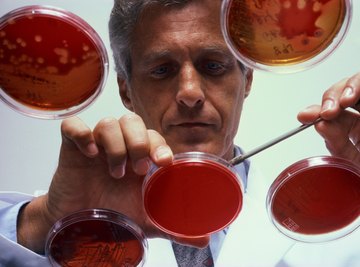
Microbiology is the study of microorganisms: microscopic or barely visible single-celled life-forms such as bacteria, archaea, protozoans and some fungi, and even some extremely small multicellular plants, animals and fungi. Microbiologists also study lifelike non-organismic phenomena such as viruses, prions, viroids and virions. "Microbe" is a catchall term for all of these entities. Enumeration in microbiology is the determination of the number of individual viable microbes in a sample; four basic techniques are possible.
Counting Cultures
One direct measure for microbial enumeration is the standard plate count, also called a viable count. For this count you culture a sample by diluting it, placing it on plates of culture medium and incubating them for a set amount of time. You then count the numbers of colonies and use this number to deduce the original number of microbes in the sample. Technically speaking, a plate count doesn't give the number of individual microbes, but rather of "colony-forming units," because you can't know for sure whether each colony actually came from a single microbe or from a tiny group of microbes. However, these counts are considered very accurate for estimating the number of microbes in original samples. Drawbacks are that this test is time- and space-consuming and requires specialized equipment that must be prepared correctly.
Individual Counts
Direct microscopic counts, also called total cell counts, are another form of direct enumeration. First you divide a sample into a number of equally sized chambers. Then you determine the average number of microbes per chamber by counting some or all under a microscope. Finally you use this average to calculate the number in the original unit. The major drawback for direct microscopic counts is that it's difficult to distinguish living microbes from dead ones, so this method may not give an accurate viable enumeration.
Rays of Light, Clouds of Microbes
Turbidity tests are forms of indirect enumeration. Turbidity is the cloudiness of a liquid. In turbidimetric measurement you put a sample in solution, measure the new solution's cloudiness by shining light through it with a spectrophotometer, then estimate the number of living microbes it would take to produce the observed cloudiness level. The drawback here is that someone must have already done numerous standard plate counts of the microbe in question in order to make sample solutions of varying turbidity, so that you have a standard to measure your current sample against. You must also beware of overly concentrating your sample, because a turbidimetric count is only accurate if no microbes in the sample are blocking any others. In a visual turbidity comparison you compare the turbidity of your sample with the turbidity of a unit of the same size and known microbial count, and estimate an enumeration based on this comparison.
Indirect Outcomes
Two other forms of indirect enumeration are mass determination and microbial activity measurement. For a mass determination enumeration, you weigh the amount of biological matter in your sample, compare this weight to a standard curve for known microbial counts and estimate the original microbial number from this comparison. For a microbial activity measurement you measure the amount of a biological product in your sample, such as metabolic waste, then compare this to a standard curve for known counts and estimate your enumeration from this comparison.
References
About the Author
Angela Libal began writing professionally in 2005. She has published several books, specializing in zoology and animal husbandry. Libal holds a degree in behavioral science: animal science from Moorpark College, a Bachelor of Arts from Sarah Lawrence College and is a graduate student in cryptozoology.
Photo Credits
Jupiterimages/Photos.com/Getty Images
